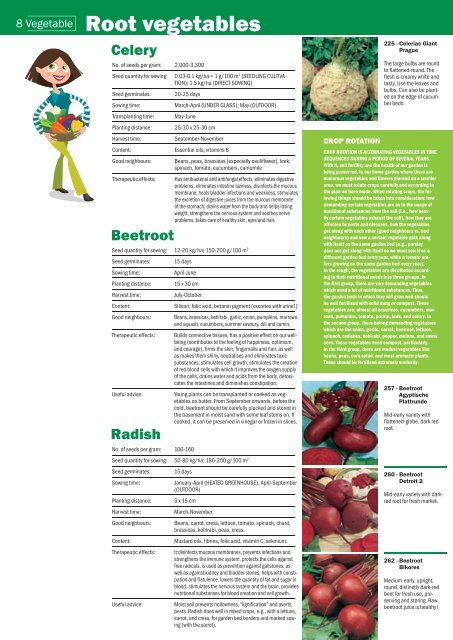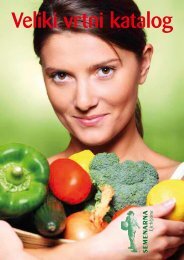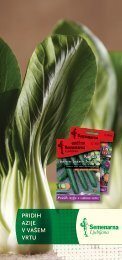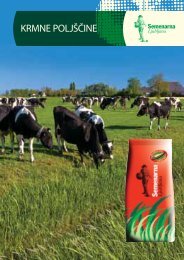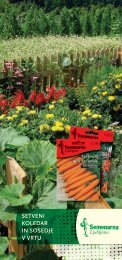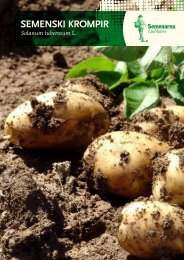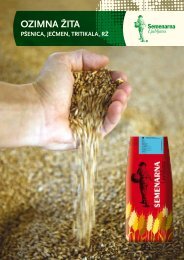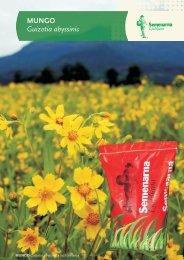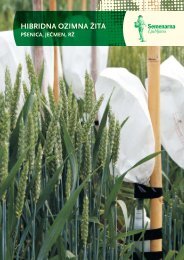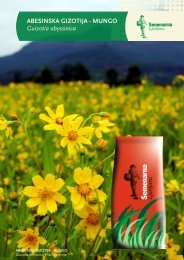katalog_ENG_20080221.indd 1 2/26/08 3:26:36 PM - Semenarna ...
katalog_ENG_20080221.indd 1 2/26/08 3:26:36 PM - Semenarna ...
katalog_ENG_20080221.indd 1 2/26/08 3:26:36 PM - Semenarna ...
You also want an ePaper? Increase the reach of your titles
YUMPU automatically turns print PDFs into web optimized ePapers that Google loves.
8 Vegetable<br />
Root vegetables<br />
Celery<br />
No. of seeds per gram: 2,000-3,300<br />
Seed quantity for sowing: 0.03-0.1 kg/ha = 1 g/100 m 2 (SEEDLING CULTIVA-<br />
TION); 1.5 kg/ha (DIRECT SOWING)<br />
Seed germinates:<br />
20-25 days<br />
Sowing time:<br />
March-April (UNDER GLASS); May (OUTDOOR)<br />
Transplanting time: May-June<br />
Planting distance:<br />
25-30 x 25-30 cm<br />
Harvest time:<br />
September-November<br />
Content:<br />
Essential oils, vitamins B<br />
Good neighbours:<br />
Beans, peas, brassicas (especially cauliflower), leek,<br />
spinach, tomato, cucumbers, camomile<br />
Therapeutic effects:<br />
Beetroot<br />
Has antibacterial and antifungal effects, eliminates digestive<br />
problems, eliminates intestine laziness, disinfects the mucous<br />
membrane, heals bladder infections and weakness, stimulates<br />
the excretion of digestive juices from the mucous membrane<br />
of the stomach, drains water from the body and helps losing<br />
weight, strengthens the nervous system and soothes nerve<br />
problems, takes care of healthy skin, eyes and hair.<br />
Seed quantity for sowing: 12-20 kg/ha; 150-200 g/100 m 2<br />
Seed germinates:<br />
Sowing time:<br />
Planting distance:<br />
Harvest time:<br />
Content:<br />
Good neighbours:<br />
Therapeutic effects:<br />
Useful advice:<br />
Radish<br />
15 days<br />
April-June<br />
15 x 30 cm<br />
July-October<br />
Silicon, folic acid, betanin pigment (excretes with urine!)<br />
Beans, brassicas, kohlrabi, garlic, onion, pumpkins, marrows<br />
and squash, cucumbers, summer savoury, dill and cumin.<br />
Builds connective tissues, has a positive effect on our wellbeing<br />
(contributes to the feeling of happiness, optimism,<br />
and courage), firms the skin, fingernails and hair, as well<br />
as makes them shiny, neutralises and eliminates toxic<br />
substances, stimulates cell growth, stimulates the creation<br />
of red blood cells with which it improves the oxygen supply<br />
of the cells, drains water and acids from the body, detoxicates<br />
the intestines and diminishes constipation.<br />
Young plants can be transplanted or cooked as vegetables<br />
on butter. From September onwards, before the<br />
cold, beetroot should be carefully plucked and stored in<br />
the basement in moist sand with some leaf stems on. If<br />
cooked, it can be preserved in vinegar or frozen in slices.<br />
No. of seeds per gram: 100-160<br />
Seed quantity for sowing: 50-80 kg/ha; 180-250 g/100 m 2<br />
Seed germinates:<br />
15 days<br />
Sowing time:<br />
January-April (HEATED GREENHOUSE), April-September<br />
(OUTDOOR)<br />
Planting distance:<br />
Harvest time:<br />
Good neighbours:<br />
Content:<br />
Therapeutic effects:<br />
Useful advice:<br />
5 x 15 cm<br />
March-November<br />
Beans, carrot, cress, lettuce, tomato, spinach, chard,<br />
brassicas, kohlrabi, peas, cress.<br />
Mustard oils, fibrins, folic acid, vitamin C, selenium.<br />
It disinfects mucous membranes, prevents infections and<br />
strengthens the immune system, protects the cells against<br />
free radicals, is used as prevention against gallstones, as<br />
well as against kidney and bladder stones, helps with constipation<br />
and flatulence, lowers the quantity of fat and sugar in<br />
blood, stimulates the nervous system and the brain, provides<br />
nutritional substances for blood creation and cell growth.<br />
Moist soil prevents hollowness, “lignification” and averts<br />
pests. Radish does well in mixed crops, e.g., with a lettuce,<br />
carrot, and cress, for garden bed borders and marked sowing<br />
(with the carrot).<br />
CROP ROTATION<br />
225 - Celeriac Giant<br />
Prague<br />
The large bulbs are round<br />
to flattened-round. The<br />
flesh is creamy white and<br />
tasty. Use the leaves and<br />
bulbs. Can also be planted<br />
on the edge of cucumber<br />
beds.<br />
CROP ROTATION IS ALTERNATING VEGETABLES IN TIME<br />
SEQUENCES DURING A PERIOD OF SEVERAL YEARS.<br />
With it, soil fertility and the health of our garden is<br />
being preserved. In our home garden where there are<br />
numerous vegetables and flowers planted on a smaller<br />
area, we must rotate crops carefully and according to<br />
the plan we have made. When rotating crops, the following<br />
things should be taken into consideration: how<br />
demanding certain vegetables are as to the usage of<br />
nutritional substances from the soil (i.e., how heavily<br />
certain vegetables exhaust the soil), how they are<br />
affected by pests and diseases, how the vegetables<br />
get along with each other (good neighbours vs. bad<br />
neighbours) and how a certain vegetable gets along<br />
with itself on the same garden bed (e.g., parsley<br />
does not get along with itself so we must sow it on a<br />
different garden bed every year, while a tomato prefers<br />
growing on the same garden bed every year).<br />
In the rough, the vegetables are distributed according<br />
to their nutritional needs into three groups. In<br />
the first group, there are very demanding vegetables<br />
which need a lot of nutritional substances. Thus,<br />
the garden beds in which they will grow well should<br />
be well fertilised with solid dung or compost. These<br />
vegetables are: almost all brassicas, cucumbers, marrows,<br />
pumpkins, tomato, potato, leek, and celery. In<br />
the second group, there belong demanding vegetables<br />
which are the onion, garlic, carrot, beetroot, lettuce,<br />
spinach, radishes, kohlrabi, pepper, melons, and sweet<br />
corn. These vegetables need compost, particularly.<br />
In the third group, there are modest vegetables like<br />
beans, peas, corn salad, and most aromatic plants.<br />
These should be fertilised extremely modestly.<br />
257 - Beetroot<br />
Agyptische<br />
Plattrunde<br />
Mid-early variety with<br />
flattened-globe, dark red<br />
root.<br />
<strong>26</strong>0 - Beetroot<br />
Detroit 2<br />
Mid-early variety with dark<br />
red root for fresh market.<br />
<strong>26</strong>2 - Beetroot<br />
Bikores<br />
Medium-early, upright,<br />
round, distinctly dark-red<br />
beet for fresh use, preserving<br />
and storing. Raw<br />
beetroot juice is healthy!<br />
<strong>katalog</strong>_<strong>ENG</strong>_<strong>20<strong>08</strong>0221.indd</strong> 8<br />
2/<strong>26</strong>/<strong>08</strong> 3:27:50 <strong>PM</strong>


